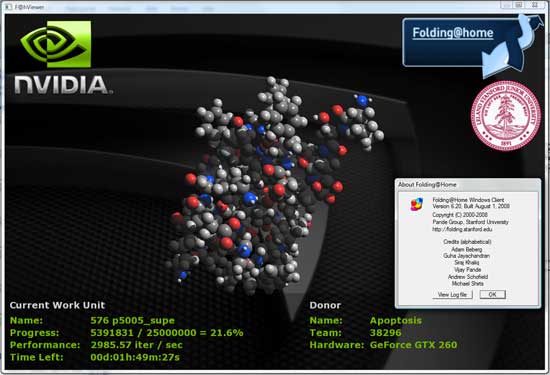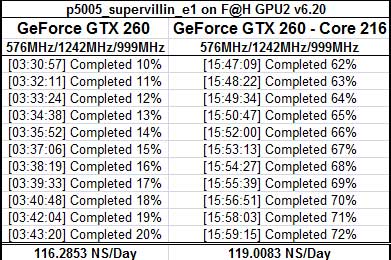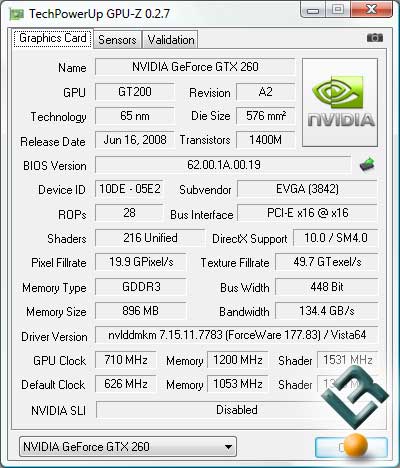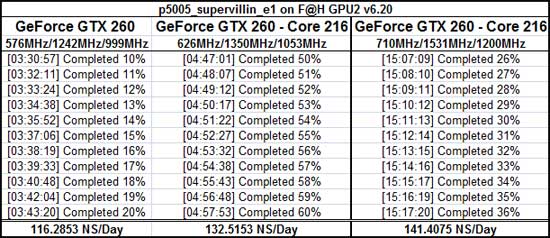EVGA GeForce GTX 260 Core 216 Superclocked Video Card
Folding @ Home
Folding @ Home
Folding@Home, the distributed-computing protein-folding application from Stanford University, runs more than 100 faster on the GPU than on the fastest CPU! We tried out F@H with the just released GPU2 client version 6.20 to see how the new GeForce 9500 GT does on the latest client and public video card drivers. This version just came out on August 1st, 2008 and features a number of improvements over previous versions that are all now expired. Folding on NVIDIA graphics cards have come a long way from when I first saw the demo working and while it is still not 100% stable (my personal system still gets driver crashes while folding), it seems to be getting close. NVIDIA has 70 million graphics cards on the market today that can run this folding client, which means that the folding project could get a huge boost in performance if more end users would join the project. To see if your video card supports CUDA, check out this list of supporting cards. If your card supports CUDA then you can try out protein folding and if you like join our folding team under 38296.

The client comes with a viewer will display a current Nanoseconds/Day performance rate (number of Nanoseconds simulated on a per-day basis) and is shown above. Why nanoseconds? Protein folding is measured in nanoseconds per day, or how many nanoseconds of the proteins life can be simulated in a days worth of computing time. The Viewer, due in part to its current requirement of moving data off and back to the GPU to render, reduces folding performance. Performance can best be measured after closing the Viewer for a little while and reading the log file. I did that on the XFX GeForce GTX 260 and the EVGA GeForce GTX 260 – Core 216 SuperClocked Edition card to see what the folding performance difference is.

- XFX GeForce GTX 260 (576MHz Core/1242MHz Shaders/2.0GHz Memory) – 116.29 NS/Day
- EVGA GeForce GTX 260 – Core 216 SuperClocked (626MHz Core/1350Mhz Shaders/2.1GHz Memory) – 132.52 NS/Day
Both GeForce GTX 260 series graphics cards were running Forceware 177.83 video card drivers and were working on the same work unit. If you are interested in the time it takes to complete a step, The EVGA GeForce GTX 260 – Core 216 was found to be 13.4% faster when it comes to folding performance, which is a significant amount as you can see in the chart above. The reason for this difference is because the XFX GeForce 216 stream processors are operating at a faster 1,350MHz. The GeForce GTX 260 Core 216 has more folding power, so if you get one of these cards be sure to download the GPU2 client and try it out for yourself.
In order to be fair I downclocked the GeForce GTX 260 Core 216 to the reference NVIDIA speeds to see how much boost the extra 24 shader processors offer.

With the clock on the original GeForce GTX 260 and the new GeForce GTX 260 Core 216 the same the performance boost was very small – only 2.34%. Even though this is just a small boost clock for clock it is still an improvement! Just for fun I tried out overclocking on the card to see how it would improve folding performance and it did by a fair amount.

With everything cranked up I fired up folding again and even though I did the testing another day I was lucky enough to have the same exact work unit that I was folding.

The overclock yielded a 7% performance boost in folding, which was great. Each step completed in 61 seconds when before it took 65-66 seconds per step. Not a bad performance boost for just a few seconds worth of overclocking. Speaking of overclocking let’s see what that does in gaming performance.

Comments are closed.